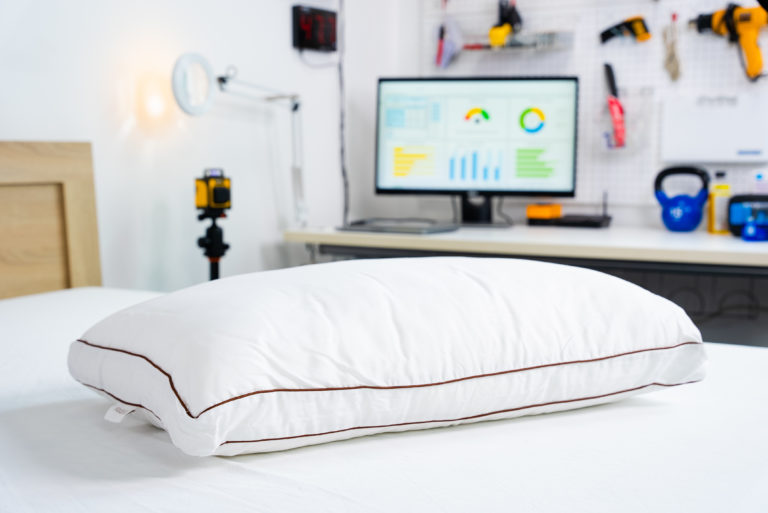When you buy through our links, we may earn a commission. Products or services may be offered by an affiliated entity. Learn more.
You spend a significant amount of time sleeping on your pillow each night. It’s important to spend those hours on a comfortable and supportive pillow—one that doesn’t leave you in pain or discomfort in the morning.
For many sleepers, a soft pillow seems like the most obvious choice for comfort. Soft pillows may be especially appealing for stomach sleepers, or those who simply prefer a plusher feel. If you’re considering a soft pillow, we’ve narrowed down some of our favorites to aid in your search. We’ll take an in-depth look at each pillow and discuss how to find the best soft pillow for you.
Our Top Picks
-
Best Overall – Cozy Earth Silk Pillow
View Details
-
Most Comfortable – Saatva Down Alternative Pillow
View Details
-
Best Down – Brooklinen Down Pillow
View Details
-
Best Value – Brooklyn Bedding Talalay Latex Pillow
View Details
-
Best for Neck Pain – Sweet Zzz Plant-Based Pillow
View Details
-
Best Eco-Friendly – Buffy Cloud Pillow – Soft
View Details
Swipe for more
Best Overall
Cozy Earth Silk Pillow
8.4 /10
Test Lab Score
25% off
25% off
Everything about the Cozy Earth Silk Pillow feels luxurious, from the mulberry silk fill to the bamboo-derived viscose cover. The durable, high-end materials justify the premium price-point.
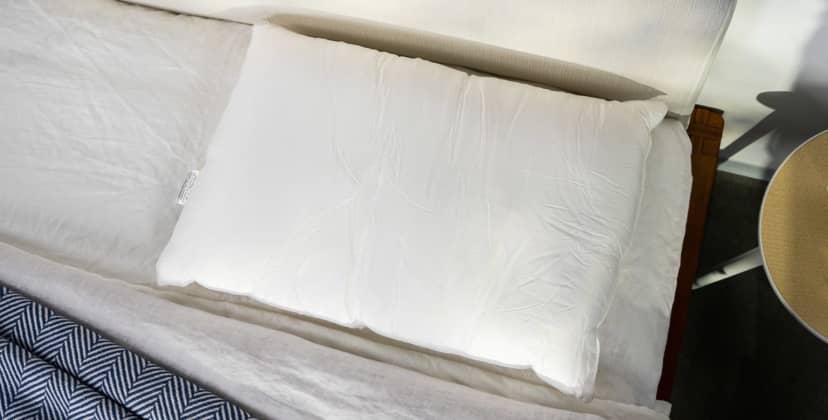
Price Range
$254 – $297
Fill
Long-strand mulberry silk
Firmness
Medium Soft
Full Details
People who experience back pain often benefit most from a pillow that is both soft and supportive. The Cozy Earth Silk Pillow has a medium soft feel that keeps your neck at a comfortable angle and evenly supports your spine without causing uncomfortable pressure points. Though this pillow has an above-average sticker price, shoppers who value high-quality materials and eco-friendly manufacturing will want to consider this model.
The Silk Pillow has a viscose from bamboo cover that feels exceptionally soft and cool to the touch. Air circulates easily between the cover and core, which helps ensure you don’t overheat. The fill is made from 100% long-strand mulberry silk that easily molds into your preferred shape and feels plush.
People with sensitive skin will likely appreciate Cozy Earth’s attention to premium materials. The bamboo used is sustainably harvested and the silk is AAA grade. The pillow’s cover can be washed in your home machine though spot cleaning is recommended to ensure its longevity.
Cozy Earth offers shoppers a generous 100-night sleep trial as well as a 10-year warranty that protects against pilling and discoloration. Shoppers who live in the contiguous U.S. enjoy free shipping.
Most Comfortable
Saatva Down Alternative Pillow
7.6 /10
Test Lab Score
Use this link for the most current discount.
Use this link for the most current discount.
The Saatva Down Alternative Pillow has a fluffy feel that mimics down but without the animal sourcing. The thick profile makes it a perfect fit for sleepers who enjoy plush pillows but still need support for the head and neck.
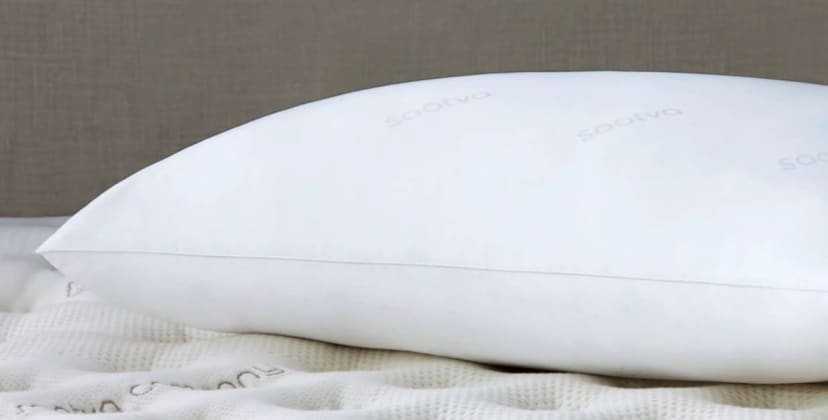
Price Range
$105 – $125
Fill
Down Alternative
Firmness
Medium
Full Details
The Saatva Down Alternative Pillow has a medium firmness that supports a wide range of sleeping positions and body types, making it a great option for combination sleepers. For those interested in a pillow to cuddle with or reshape for varying sleep positions, the Saatva Down Alternative Pillow offers good moldability. This pillow is offered in a queen or king size.
The cover is made of breathable organic cotton with decorative satin piping. Microdenier fibers and polyester memory clusters are made to mimic the feel of natural down, with the microfiber adding loft and the polyester memory clusters providing a slightly firmer base. This down alternative blend is designed to give the pillow the feel of a softer down pillow, while still supporting the head and neck. There are no animal products included in the pillow, and it is designed to be resistant to allergens.
The Saatva Down Alternative is made in the U.S. and ships free to anywhere in the lower 48 states. Saatva provides a 45-night sleep trial.
Best Down
Brooklinen Down Pillow
9.2 /10
Test Lab Score
15% off sitewide
15% off sitewide
There’s nothing like a down pillow to maximize comfort, and the Brooklinen Down Pillow is no exception. The design is exceptionally plush and compresses deeply under your head. The price-point is also very reasonable compared to other down pillows we’ve tested.

Price Range
$109 – $149
Fill
Canadian white down clusters or down/feather blend
Firmness
Plush, Mid-Plush, Firm
Full Details
Filled entirely with down clusters, the Brooklinen Plush Down Pillow has a plush feel that allows sleepers to sink in, providing optimal spinal alignment for stomach sleepers. Brooklinen also offers Mid-Plush and Firm versions of this pillow, which blend the down with feathers for a firmer feel and higher loft. The Brooklinen Down Pillow is available in standard or king size.
The Brooklinen Down Pillow carries OEKO-TEX Standard 100 certification, indicating it has been tested for harmful substances. It is also treated with antimicrobials intended to remove common allergens.
The cover is made with long-staple cotton in a smooth sateen weave with a 400 thread count. This provides a durable and breathable sleep surface, and double stitching around the edges helps keep the down contained. The down used in the filling is acquired from ethically run Canadian farms.
Brooklinen offers a 365-night sleep trial, as well as a 1-year warranty after the sleep trial is up.
Best Value
Brooklyn Bedding Talalay Latex Pillow
9.0 /10
Test Lab Score
25% off sitewide
25% off sitewide
The Brooklyn Bedding Talalay Latex Pillow offers excellent neck support thanks to pushback from the latex, but it also provides enough cushioning to prevent the kind of pressure buildup that can occur with highly supportive pillows.
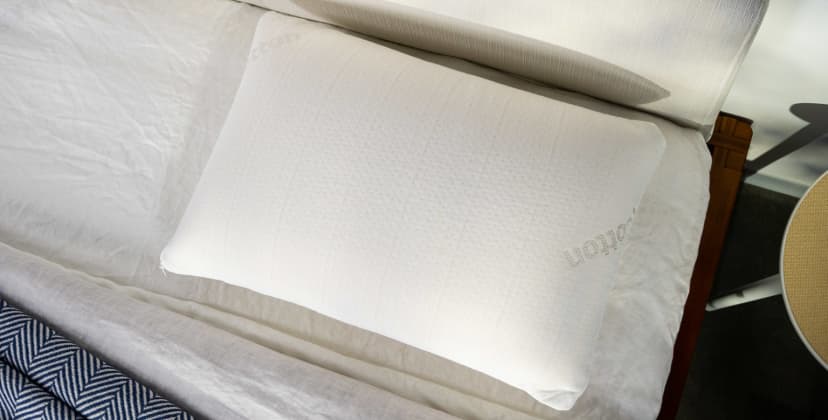
Price Range
$89 – $99
Fill
Talalay latex
Firmness
Medium Firm
Full Details
If you live with chronic or frequent neck pain, the pillow you choose can make a world of difference. Some people prefer the close, hugging effect of memory foam — but if you aren’t a fan of this material, the Brooklyn Bedding Talalay Latex Pillow might be right up your alley. The solid latex core gently cushions the head and neck, but also feels responsive and shouldn’t contour too deeply. Latex also retains less heat and sleeps cooler than memory foam, and this pillow gets an extra temperature-regulating boost from its moisture-wicking Tencel shell.
Two loft levels are available. Our tests show the 4-inch design is best suited to back and stomach sleepers, as people who use these positions may feel neck strain when lying on high-profile pillows. We recommend the thicker profile for side sleepers, who often need extra padding between the head and downward-facing shoulder to promote even alignment and alleviate pressure along the spine.
You may remove and machine-wash the cover as needed, but the latex insert should only be spot cleaned if stains or smudges occur. Queen and king sizes are available. Both carry below-average sticker prices compared to other latex pillows sold today, and Brooklyn Bedding offers free ground shipping to all customers in the contiguous U.S. Each purchase includes a 30-night sleep trial. If you decide to keep the pillow after the trial ends, it’s covered under a three-year warranty.
Best for Side Sleepers
Eli & Elm Cotton Side-Sleeper Pillow
8.9 /10
Test Lab Score
20% off
20% off
The Eli & Elm Cotton Side-Sleeper Pillow is designed specifically with side sleepers in mind, from the cutout shape that accommodates your shoulder to the latex and polyester fill that maintains support. The cherry on top is the adjustable loft, which is ideal for sleepers who need a just-right thickness.

Price Range
$115 – $124
Fill
75% shredded latex or shredded memory foam, 25% polyester fiber
Firmness
Medium, Adjustable
Full Details
As the name implies, the Eli & Elm Cotton Side-Sleeper Pillow is a great match for people who prefer sleeping on their sides. The pillow’s U-shape design curves slightly at the bottom to promote spinal alignment and keep neck pain at bay. This pillow also has a highly versatile fill that can be adjusted to suit each sleeper’s specific preferences.
You can add and remove this pillow’s 75% latex and 25% polyester fill as needed, allowing you to customize the loft level. Side sleepers should use the most fill, as they typically prefer a pillow with fairly high loft levels. Back and stomach sleepers who find this pillow’s shape comfortable can remove fill to lower the loft to a more suitable height. Shoppers who want a firmer, taller pillow can purchase additional fill directly from Eli & Elm.
Hot sleepers will also want to consider this model, thanks to its temperature-neutral fill and breathable cover material. The latex and polyester don’t retain much body heat when compared to other pressure-relieving materials like memory foam. The polyester, organic cotton, and spandex blend cover is washable and shoppers can opt to add on a pillowcase that easily fits this model’s unique shape.
Each purchase of the Cotton Side-Sleeper Pillow includes a 5-year warranty that covers material and manufacturing defects. Shoppers within the contiguous U.S. enjoy free shipping and 45-day returns.
Best for Neck Pain
Sweet Zzz Plant-Based Pillow
8.4 /10
Test Lab Score
Use code SF10 for 10% off sitewide
Use code SF10 for 10% off sitewide
The Sweet Zzz Plant-Based Pillow is an excellent pick if you prioritize squishable softness in your pillows. The down alternative fill is perfectly fluffy and lightweight, and it’s made with plant-based fibers that may appeal to eco-friendly shoppers.
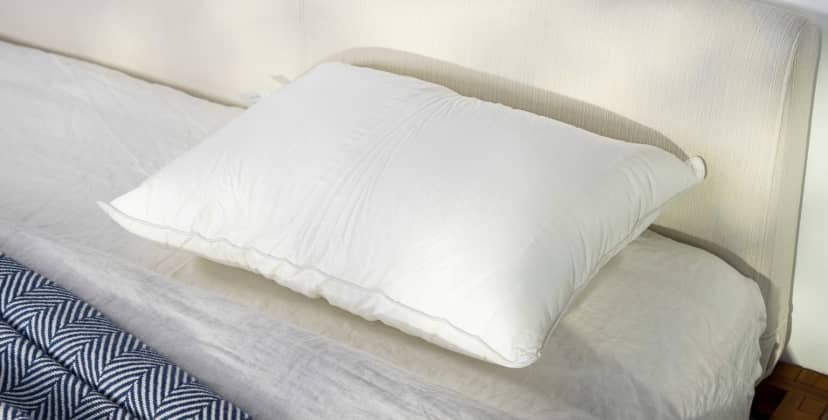
Price Range
$135 – $150
Fill
Plant-based down alternative fibers
Firmness
Medium
Full Details
The most comfortable pillow for any given person largely depends on their sleep position. Back sleepers often prefer a mid-range profile that provides adequate plushness and support without elevating the head too much. For this reason, the Sweet Zzz Plant-Based Pillow is a good option for those who favor the back position. Down alternative fill cradles the head, but the pillow is thin enough to maintain even alignment and prevent neck strain.
As its name implies, the pillow’s fill is derived from plant matter and does not contain any synthetic components. The shell is composed of natural cotton with a silky-smooth feel. These elements make the pillow a good choice for shoppers who prefer to invest in eco-friendly products. The cotton is highly breathable and the fill won’t retain too much heat, so the pillow is also suitable for hot sleepers.
Queen and king sizes are available. The pillow can be laundered in any household machine for quick and easy care. Wash with similar colors in cold water on a gentle cycle, then tumble dry on low heat. You can also use your dryer to fluff up the pillow and recover its full shape, as the fill may flatten over time.
Both sizes of the pillow are affordably priced. Sweet Zzz offers free ground delivery throughout the contiguous U.S. and reasonable shipping rates for Canadian customers. Each purchase comes with a sleep trial that spans 50 nights and includes free returns. Those who decide to keep their Plant-Based Pillow also receive a 1-year warranty against structural and workmanship defects.
Best Temperature Regulating
Sijo FluffBase Eucalyptus Pillow
7.1 /10
Test Lab Score
Use this link for the most current Sijo discounts
Use this link for the most current Sijo discounts
The Sijo FluffBase Eucalyptus Pillow is composed entirely of Tencel lyocell, which is known for its excellent cooling properties. It traps minimal heat and helps wick moisture if you tend to sweat a lot at night.
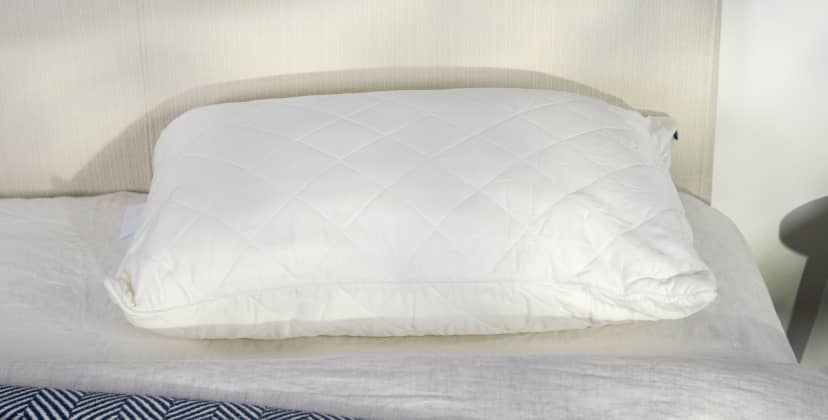
Price Range
$60 – $80
Fill
Tencel down alternative fibers
Firmness
Medium Soft
Full Details
The FluffBase Eucalyptus Pillow from Sijo is made with materials that promote cooling throughout the night, even in warmer climates. The price-point is lower than pillows with similar quality and design, making this a strong pick for shoppers on a budget.
Both the shell and fill of this pillow are composed of Tencel lyocell fibers derived from eucalyptus trees and a blend of other wood sources. The result is a medium soft feel that mimics the plushness of down, making this ideal for sleepers who enjoy down pillows but prefer products that are not sourced from animals. Back and side sleepers who enjoy softer pillows should find this model comfortable, though stomach sleepers may prefer a pillow with less loft.
The pillow is available in a standard/queen and king size. The cover is removable, and Sijo recommends washing the cover and core separately. You may machine wash at home on a gentle cycle in cold water, then tumble dry on a low setting.
Sijo provides free shipping on orders over $65. Shoppers who return the pillow within 30 days may receive a full refund, as long as the pillow is undamaged and free of stains.
Best for Combination Sleepers
Helix Down & Feather Pillow
9.2 /10
Test Lab Score
Use this link for the most current discount.
Use this link for the most current discount.
The Helix Down & Feather Pillow pulls off a tricky balance of supporting the head and neck while still ensuring enough plushness to prevent pressure buildup. The three-chamber design is great for most people regardless of their sleep position.
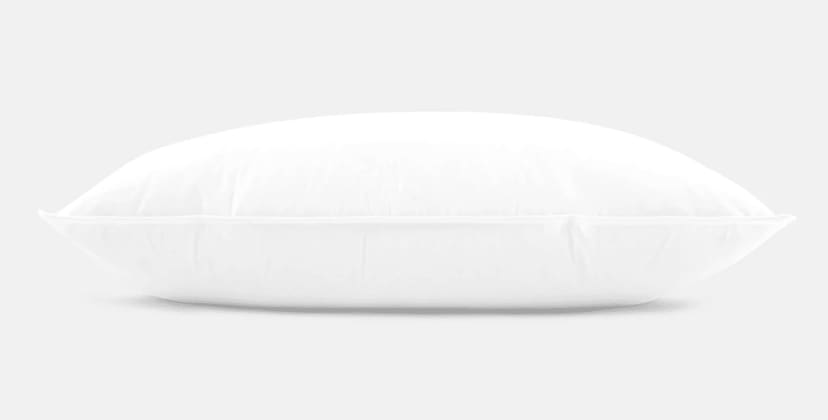
Price Range
$95 – $110
Fill
White Down, Feathers
Firmness
Soft
Full Details
Choosing a pillow based on your sleep position can be tricky if you’re a combination sleeper who switches between your side, back, and stomach over the course of a single night. The Helix Down & Feather Pillow is exceptionally moldable, allowing you to squish the fill into a flat surface when lying face-down, prop it up for back sleeping, and fluff it for a full shape that provides ample cushioning for sleeping on your side. A three-chamber design ensures plushness along the outer surface and sturdy interior support.
A cotton cambric shell encases the fill. This fabric is naturally breathable to offset heat retention, and also silky-smooth to prevent irritation for people with sensitive skin. Thick piping reinforces the seams to prevent rips and tears. You may machine-wash the pillow if your household appliance is large enough to accommodate it. Dry cleaning or visiting the laundromat are alternative options. Standard and king sizes are available.
The pillow has earned certification from the Responsible Down Standard, ensuring Helix adheres to rigid standards regarding animal treatment and welfare. The company also offers free ground shipping to customers in all 50 states. Each Down & Feather Pillow comes with a 100-night trial period. If you decide to keep the pillow after the trial ends, your purchase is also covered under a one-year manufacturer’s warranty against material defects.
Best Eco-Friendly
Buffy Cloud Pillow – Soft
7.4 /10
Test Lab Score
The Buffy Cloud Pillow has a luxuriously plush feel that perfectly mimics down — but at a fraction of the price of down pillows. The down alternative fill excels at cushioning and pressure relief.

Price Range
$55 – $70
Fill
Recycled PET fibers
Firmness
Soft
Full Details
Buffy has earned a reputation for high-quality, eco-friendly sleep products that are also affordably priced. The Cloud Pillow embodies all of these qualities. You can choose from three firmness levels for the pillow, including a soft design that deeply compresses beneath your head and neck. Back and stomach sleepers should get the cushioning they need from this design without any neck strain — a common problem for people who use this position when they sleep on firm pillows.
The fill consists of PET down alternative fibers derived from recycled plastic bottles. Roughly 25 bottles are used to produce each pillow. A moisture-wicking Tencel shell encases the fill. Since the Tencel also comes from sustainably sourced eucalyptus trees, the pillow should appeal to eco-conscious individuals. The pillow does not contain any essential oils, and is considered safe for both children and pets.
Buffy does not recommend machine-washing the pillow. Use a pillowcase to protect the insert from stains and contaminants, and spot clean or dry clean as necessary. If you are a side sleeper, consider the medium or firm designs instead — these provide more padding to support your head and promote proper spinal alignment. Standard and king sizes are available.
In addition to reasonable pricing for individual purchases, customers receive a $10 discount when they purchase two pillows and a $50 discount when they purchase four. You can test the pillow for seven nights before Buffy charges your credit card. After that point, your purchase is backed by the company’s standard 50-night trial.
Best Overall
Cozy Earth Silk Pillow
8.4 /10
Test Lab Score
25% off
Shop at Cozy EarthA luxuriously soft and breathable pillow filled with plush mulberry silk and encased in a cooling bamboo-derived cover, designed to cradle the neck and support spinal alignment.
See More Details
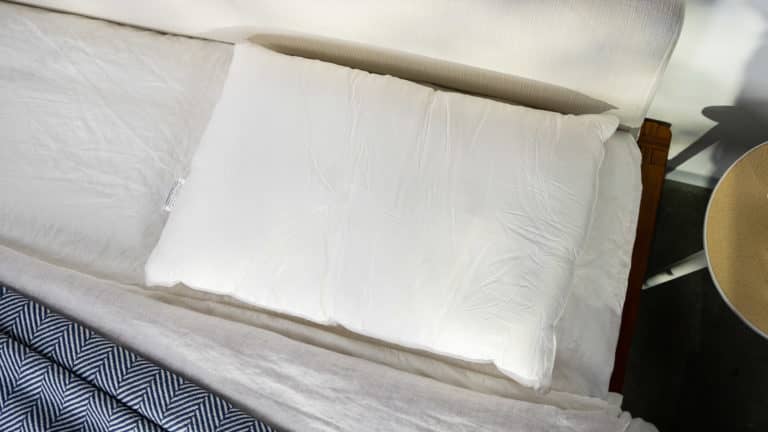
Most Comfortable
Saatva Down Alternative Pillow
7.6 /10
Test Lab Score
Use this link for the most current discount.
Shop at SaatvaA breathable, animal-free pillow with a soft-yet-supportive feel that adapts well to different sleep positions, thanks to its moldable down alternative fill and organic cotton cover.
See More Details
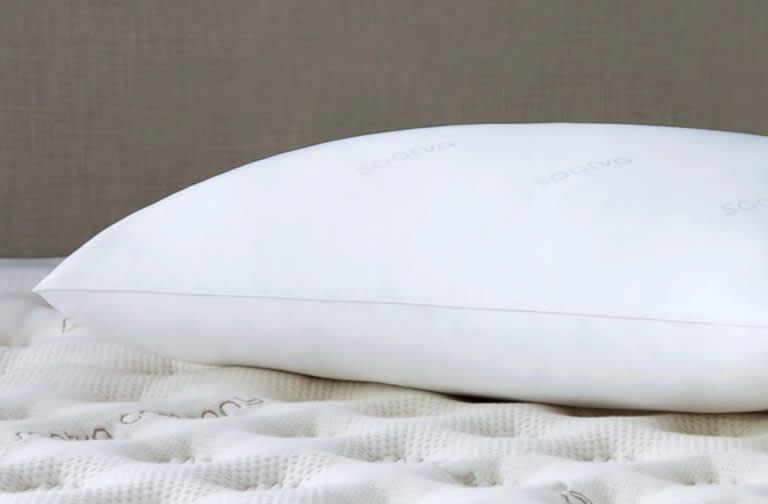
Best Down
Brooklinen Down Pillow
9.2 /10
Test Lab Score
15% off sitewide
Shop at BrooklinenA soft, breathable down pillow with a luxurious feel that’s ideal for stomach sleepers seeking gentle support and plush sinkage, made with ethically sourced materials and certified for safety.
See More Details
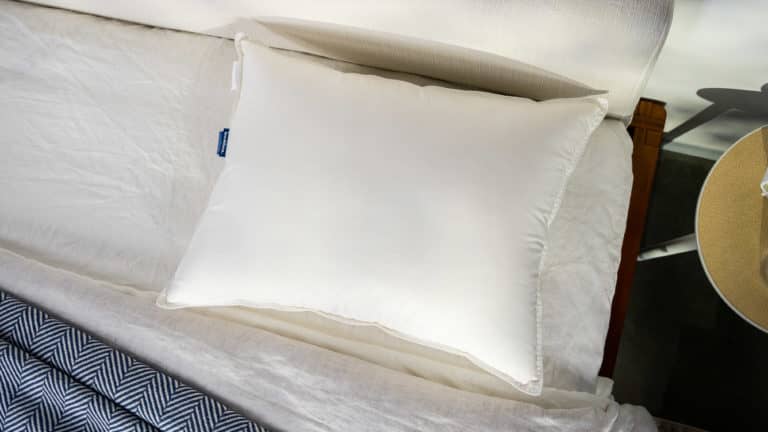
Best Value
Brooklyn Bedding Talalay Latex Pillow
9.0 /10
Test Lab Score
25% off sitewide
Shop at Brooklyn BeddingA responsive, breathable latex pillow with a moisture-wicking cover that gently supports the head and neck while sleeping cooler than memory foam.
See More Details
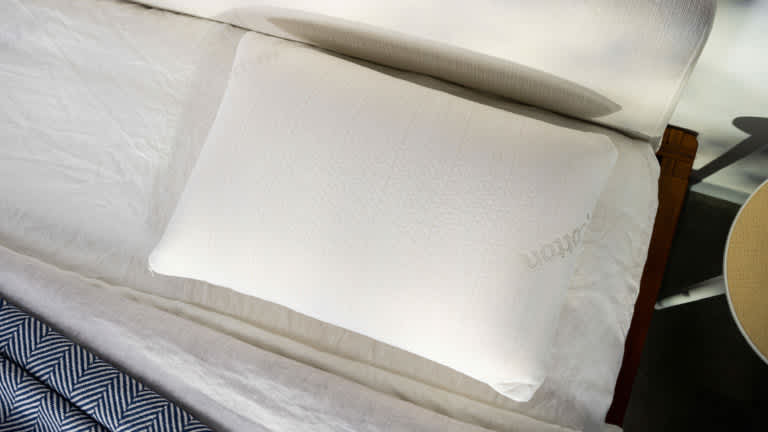
Best for Side Sleepers
Eli & Elm Cotton Side-Sleeper Pillow
8.9 /10
Test Lab Score
20% off
Shop at Eli & ElmA uniquely shaped, adjustable-fill pillow designed to support side sleepers by promoting better spinal alignment and offering customizable loft and firmness for personalized comfort.
See More Details
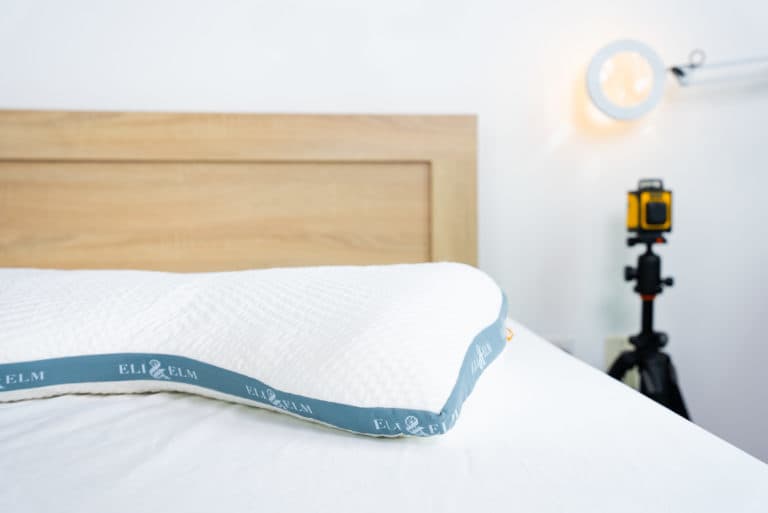
Best for Neck Pain
Sweet Zzz Plant-Based Pillow
8.4 /10
Test Lab Score
Use code SF10 for 10% off sitewide
Shop at Sweet ZzzAn eco-friendly, plant-based pillow with a mid-range loft that offers balanced support and breathability — ideal for back sleepers and hot sleepers.
See More Details

Best Temperature Regulating
Sijo FluffBase Eucalyptus Pillow
7.1 /10
Test Lab Score
Use this link for the most current Sijo discounts
Shop at SijoA budget-friendly, eucalyptus-derived pillow with a plush, down-like feel that offers breathable, animal-free comfort for back and side sleepers.
See More Details
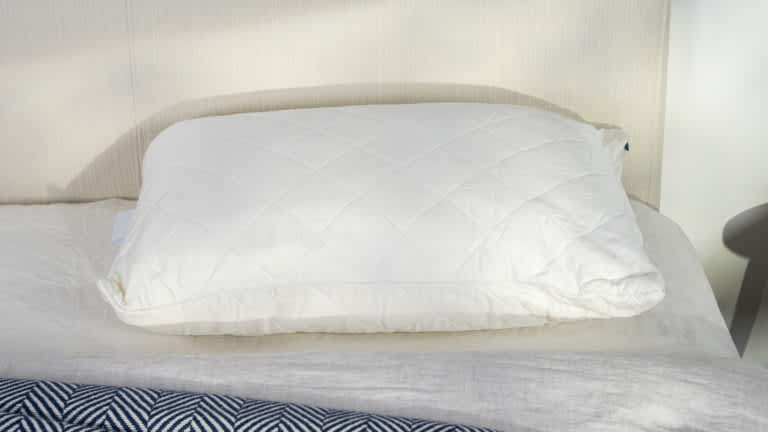
Best for Combination Sleepers
Helix Down & Feather Pillow
9.2 /10
Test Lab Score
Shop at Helix
Shop NowA breathable, moldable down and feather pillow with a three-chamber design that adapts easily to different sleep positions, making it a great fit for combination sleepers.
See More Details
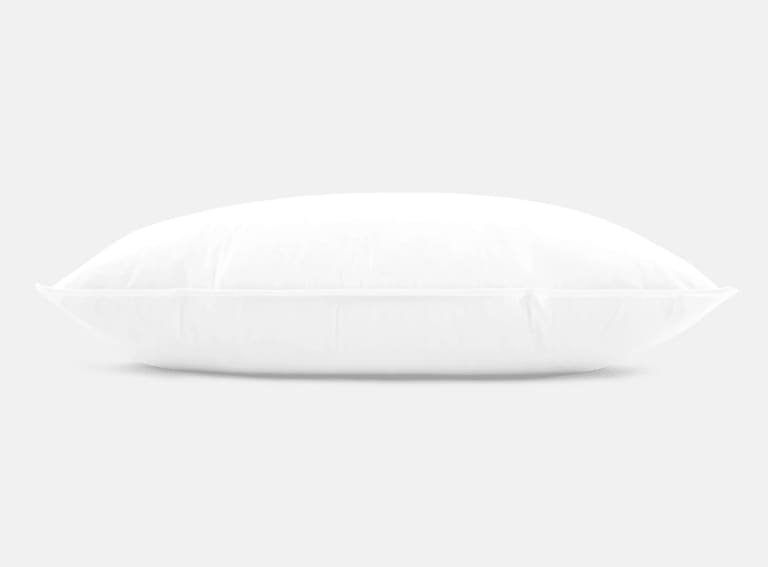
Best Eco-Friendly
Buffy Cloud Pillow – Soft
7.4 /10
Test Lab Score
A soft, eco-friendly pillow made with recycled down alternative fill and a breathable Tencel shell, offering gentle support and sustainable comfort for back and stomach sleepers.
See More Details

How We Test: Rigor, Data, and Sleeper Feedback
Our team has years of experience testing pillows and other types bedding, and we choose our top product picks based on extensive in-house testing. To evaluate buckwheat pillows, we assess their comfort and breathability. We also examine other qualities like additional materials and adjustability. Our process consists of four primary stages.
Construction analysis: We begin by closely examining the pillow and making note of its material composition. This helps us determine durability and overall quality.
Product testing: In our Seattle Test Lab, team members take turns using the pillow. By doing so, we can see how comfortable and supportive the pillow is. We can also evaluate breathability, moisture control, and overall temperature regulation.
Field testing: Once our in-house tests have concluded, team members take the pillow home and test them in their own bedrooms for two to three weeks. Their daily notes help us understand how the pillow performs in real-world sleep environments.
User testing: We collect data from customer surveys and product reviews to see if our initial ratings align with opinions from the general public, or if they’re off the mark.
How to Choose a Soft Pillow
Many bedding companies market their pillows as “soft” or “like sleeping on a cloud” because it sounds enticing and comfortable. However, no pillow is a universal fit, and the best model for you depends on your sleeping style, your personal preference, and other factors.
With so many pillow choices on the market today, it’s helpful to focus on a few key elements of a pillow to determine which is the right fit for you.
Sleeping Position
Your sleeping position affects how far your head is from the mattress, and therefore what type of pillow you need to keep the head, neck, and spine aligned. Side sleepers generally need a firmer, higher pillow in order to fill the space between the shoulder and the head. Back sleepers tend to prefer a medium loft, medium firm pillow that keeps the neck supported without exaggerating the angle of the head. For stomach sleepers, a softer pillow with a low loft is usually best.
Loft
The loft of a pillow refers to its height when lying flat. Pillow loft is generally categorized as low (less than 3 inches), medium (3 to 5 inches), or high (more than 5 inches). Keep in mind that the pillow usually compresses once your head is laid on the pillow. Thus, pillow loft should be considered in conjunction with pillow firmness, bearing in mind that softer pillows compress more.
Support
A supportive pillow helps keep the head and neck in alignment with the rest of the spine. This allows the shoulders and neck to relax, reducing the chances of soreness in the morning. Typically, firmer pillows are considered more supportive, since they keep the head from sinking. However, the level of support is a product of several factors, and you may find a softer pillow more appropriate depending on your sleeping style.
Firmness Level
Pillow firmness refers to the feel of the pillow and how much your head sinks in. The firmness level varies according to the type and density of the materials in the pillow. Most pillows can be categorized as soft (or plush), medium soft, medium, medium firm, or firm.
Pressure Relief
Pressure relief is tied to firmness, as a pillow that is too hard may cause pressure points if sleepers stay in one position for too long. This is especially relevant for side sleepers, whose ears make prolonged contact with the pillow and may be more sensitive than other areas. Soft pillows or materials that conform closely generally provide better pressure relief.
Shape
Most pillows are rectangular, but some pillows feature unique shapes that are specially designed for certain sleep positions. Many ergonomic pillows, for example, have a structure of curves and dips to support specific areas of the head, neck, and shoulders. Pillows for side sleepers may also have a cut-out section for the shoulders, whereas wedge-shaped pillows are popular with people who want to elevate their upper body.
Price
Pillows come in a wide range of prices, from tens to hundreds of dollars. Pricing is predominantly determined by a pillow’s materials and construction. For example, pillows with organic certifications or those made from premium materials are generally more expensive than synthetic options. Shoppers may also pay more for complex or proprietary designs.
Quality Materials
The quality of materials used in a pillow directly affects its longevity, comfort, and price-point. Cheaply made pillows may be quicker to flatten or become bunchy. Natural materials or denser foams may represent a larger investment at first, but the investment can pay off in the long run if the pillow is more durable.
Moldability
Many sleepers prefer a huggable pillow that can be squashed into different positions while sleeping, or folded in half to make a backrest when reading in bed. Soft pillows tend to have good moldability, though some feature gussets or other designs meant to help them keep their original shape.
Temperature Regulation
Pillows made with breathable materials can help reduce heat buildup and provide a more comfortable sleep surface. To stay cool, both the fill and the cover should allow room for airflow. Materials such as wool, cotton, and latex are naturally breathable. By contrast, materials such as down or memory foam may trap more heat. Manufacturers sometimes use an aerated design, phase change material, or other techniques to promote temperature neutrality.
Who Is Best Suited to a Soft Pillow?
Soft pillows are favored by much of the population. For stomach and back sleepers, a soft pillow allows the head to settle down closer to the mattress for optimal spinal alignment. For side sleepers, a soft pillow helps reduce pressure points at the ears. Due to their malleability, soft pillows are also popular with people who like to snuggle or scrunch their pillow into different shapes. A small, soft pillow tucked under the legs or lumbar spine may help relieve pressure in the lower back.
A pillow’s firmness level impacts both pressure relief and support. Sleeping on a pillow that is too firm may be uncomfortable, or even cause pressure points where the head touches the pillow.
However, sleepers should take into account that a softer pillow compresses more when laying on it. This means that side sleepers and those who weigh more than 230 pounds may need to buy a higher pillow to make up for the plush sinking effect. Side and stomach sleepers should also be aware that an overly soft pillow may restrict breathing if it allows the face to sink down too far.
It’s impossible to choose a pillow based on firmness alone, as the loft also plays a very important role. You may also need to consider how plush your mattress is, how much your head weighs, whether you have any special pain points to consider, and your own personal preference.
What Types of Pillows Are There?
Pillows can be constructed from a variety of different materials, each of which come with their own unique feel, level of support, and price-point. Some pillows also combine two or more materials to capitalize on the benefits of each one.
Polyfoam: Polyfoam, or polyurethane foam, is a synthetic material that offers moderate contouring. Polyfoam pillows are usually on the firmer side. They may be aerated with pincore holes to increase airflow, shredded to increase contouring, or blended with other materials to add a sturdier core. Polyfoam pillows are usually quite economical, though they may not last as long as other types.
Memory Foam: Memory foam is also known as viscoelastic polyfoam, a name that accurately captures the material’s ability to contour around the sleeper’s body and then slowly regain its shape when pressure is lifted. The enhanced contouring gives it a softer feel than polyfoam, especially if the memory foam is shredded. Memory foam pillows tend to trap heat, an issue which some manufacturers try to solve by adding gel infusions or phase change material.
Down: Down refers to the soft, light feathers of a goose or duck that lay beneath the coarser outer feathers. A down pillow typically starts out fluffy and then compresses considerably when you lay on it. Down is moldable and durable, but it tends to be expensive and it may trigger allergies. Shoppers interested in animal welfare may want to look for ethically sourced and cruelty-free down.
Down Alternative: Down alternative pillows attempt to provide the same soft, fluffy feel of a down pillow without the use of animal products. Typically made with polyester fibers, down alternative is less expensive than down. Like down, down alternative tends to sink in as weight is applied, which is helpful for pressure relief but which may not provide the support of a foam or latex pillow.
Latex: Made from the sap of the rubber tree or synthesized from chemicals, latex is a durable material that provides a moderate level of contouring and firm support. Latex is naturally breathable, and latex pillows may be aerated with additional holes for increased airflow. Latex is generally firm and comes pre-molded, making it difficult to reshape if needed. However, some latex pillows are made with shredded latex, which is more moldable.
Feather: Feather pillows aren’t quite as fluffy as down pillows, but they tend to be more affordable. Sleepers can also purchase blended feather and down pillows. As with down pillows, feather pillows offer good moldability, and they allow sleepers to sink in quite far. They are quite durable, but with repeated use, they may start to flatten and need to be re-fluffed. Feather pillows may trigger allergies, and they require a bit more effort to keep clean.
Buckwheat: Buckwheat pillows, made from buckwheat hulls that lock together to form a firm, supportive feel, are becoming increasingly popular. Most buckwheat pillows are customizable and allow the user to adjust the loft by adding or removing buckwheat hulls. Buckwheat pillows are very durable and offer great airflow for hot sleepers. However, buckwheat pillows offer minimal pressure relief and may not be a suitable choice for someone who prefers a soft pillow.
Wool: Wool is a durable natural fiber collected from lamb or sheep. Wool fibers have a crimped shape that makes them quite resilient and springy. The fibers also excel at wicking moisture, helping sleepers stay cool when it’s hot and warm when it’s cold. Wool is more often added as extra padding, but wool itself typically has a medium firm feel with moderate contouring.
Water: A less common type of pillow is the water pillow, which is typically constructed with a water chamber surrounded by padding. Users may be able to customize the loft and firmness by adding or removing water. Water pillows tend to provide good support and cooling. However, when the water pouch is full, the pillow becomes quite heavy and there is a small potential for leakage.
Pillow covers also come in a variety of materials, such as cotton, polyester, or Tencel. Cotton and Tencel are soft and breathable, while polyester is inexpensive, lightweight, and easy to care for. Pillow covers may also be made with blended materials, often featuring stretchy materials such as spandex.
Pillow Firmness and Sleeping Position
A pillow’s job is to support your head at a comfortable height to keep the head, neck, and spine aligned. As sleeping position dictates how far your head is from the mattress, your preferred sleeping position also affects how firm your pillow needs to be. Within the requirements of each sleeping position, individual sleepers may also have their own preferences.
Side Sleepers and Pillow Firmness
Side sleepers typically prefer a medium to firm pillow. Sleeping on your side puts more pressure on the shoulders and creates a sizable gap between the shoulder and head. The pillow must be firm enough to support the neck and take pressure off the shoulders. That said, a pillow that is too firm may cause pressure buildup where the head touches the pillow. Materials like memory foam or latex tend to provide the best balance of pressure relief and support. Gusseted down or down alternative pillows may also hold up better than non-gusseted models.
Back Sleepers and Pillow Firmness
Back sleepers tend to prefer a medium to firm pillow that keeps the head at a neutral angle. Back sleeping doesn’t tend to cause much pressure buildup, as only the back of the head makes contact with the pillow. These sleepers can choose from a wide range of moderately contouring pillow materials, including down, latex, memory foam, polyfoam, and wool.
Stomach Sleepers and Pillow Firmness
Softer pillows are usually better for stomach sleepers, who are prone to pressure buildup from twisting the neck to one side. This pressure is typically less severe with a flatter pillow, as a higher pillow can add extra strain by tilting the head backwards. A pillow made of down, down alternative, or shredded memory foam allows the head to sink in while offering a soft surface for the face. Moldable pillows may also be preferred by stomach sleepers who hug their pillow while they sleep.
What Is Pillow Loft?
Pillow loft refers to the height, or thickness, of a pillow when it is resting on a flat surface. Low loft is typically defined as less than 3 inches, medium loft as between 3 and 5 inches, and high loft as more than 5 inches. When considering pillow loft, it helps to remember that most pillows compress when you lay on them. The ideal loft depends on several factors:
- Sleep Position: Side sleepers typically require a pillow with a high loft to keep the head and neck aligned. Back sleepers need a pillow with a medium loft to raise the head just slightly, and stomach sleepers need very little loft to keep the neck at a comfortable angle. Combination sleepers can choose an intermediate loft, or look for a pillow with an ergonomic design.
“Side sleepers tend to need a high-loft pillow for support and to fill the space beneath the head and neck to promote proper spinal alignment. Keep your head and neck in alignment at around 30 degrees with the help of a good pillow so your airway stays open during the night, allowing air to flow from your nose to your lungs without obstruction.”
– Sarah Silverman, Psy.D., a licensed psychologist and holistic sleep wellness consultant who treats patients in New York and Florida.
- Head Size: Sleepers with a heavier or larger head may require a pillow with a higher initial loft, as these individuals experience more compression when laying on the pillow. Children or those with smaller, lightweight heads may opt for a medium or low-loft pillow, as they don’t sink in as far.
- Body Weight: Body weight affects how far the sleeper sinks into the pillow and the mattress. Sleepers over 230 pounds sink into the mattress more, causing the pillow to feel comparatively higher as a result. For these sleepers, a lower pillow may be appropriate. Those who weigh less than 130 pounds stay more on top of the mattress, and may require a higher pillow to lift the head and keep the spine aligned.
- Mattress Firmness: Similar to body weight, mattress firmness affects the extent to which a person sinks into the mattress versus laying on top of it. A soft mattress allows for deeper sinking. By contrast, a firm mattress allows the sleeper to sleep higher on the bed, potentially requiring a higher pillow.
What Pillow Sizes Are Available?
The most common pillow sizes are standard, queen, and king. However, you may also find specialty sizes such as super standard pillows or body pillows. While sizing is fairly standardized, different brands may vary by a few inches, so it’s good policy to check the dimensions before ordering to make sure the pillow fits your pillowcase and your bed. Note that the depth of the pillow doesn’t typically vary, just the width.
- Standard: Measuring 20 inches by 26 inches, the standard pillow is the most common pillow size and it can be used for most sleep positions. One standard pillow fits across a twin mattress, and two standard pillows fill most of the width of a full or queen mattress, while still leaving some space for the sleeper to tuck their arms around either end.
- Super Standard: Super standard pillows are slightly longer than standard pillows, at 20 inches by 28 inches. This size may be a good fit for restless sleepers or those who enjoy a slightly longer pillow. Though it’s suitable for most beds, this size is less common and may be difficult to find.
- Queen: Queen pillows are about 4 inches longer than a standard, measuring 20 inches by 30 inches. They are designed to be used with queen mattresses, though they can also be used with a twin mattress. Queen pillows give sleepers a little more room to play with and because they are so common, they are easy to find and easy to match with pillowcases.
- King: King pillows measure 20 inches by 36 inches. They are beneficial for restless sleepers or those who like to curl up with their pillow. A king pillow is a little too long to fit comfortably on a twin mattress, though it can be used by a single sleeper on a full mattress. Likewise, two king pillows don’t fit on a queen mattress, but they fit perfectly across a king or California king mattress.
- Body Pillow: Body pillows are extra-long pillows designed to provide support for different areas of the body. Sleepers can hug the pillow between the knees to level out the hips, or experiment with other positions. Body pillows are frequently used by side sleepers and pregnant women. The standard dimensions are 20 inches by 54 inches, though it’s not uncommon to find variations.
More Pillow Guides
If you’re still not sure you’ve found the perfect pillow, take a look at some of our other recommendations based on material.
Frequently Asked Questions
How much do soft pillows cost?
A standard size soft pillow can range in price from $30 to $180 or more, but the average price lies between $75 and $100. Many factors determine how a pillow is priced, notably the quality of the materials and the design. Softer pillows may cost less than firmer equivalents because they contain less fill, meaning the manufacturing cost is not as high.
How often should I replace my pillow?
The general standard is to replace a pillow after 1 to 2 years, though this timeline can vary depending on the materials. Soft pillows may wear down sooner than firmer models, as they undergo more compression. Keeping your pillow well-maintained and regularly cleaning it may help extend its lifespan. You’ll know it’s time to replace your pillow when it starts to provide less support and you find yourself waking up sore.
Are soft pillows good for you?
Soft pillows can provide pressure relief, but the benefits of a soft pillow depend on the sleeper. Soft pillows tend to be most comfortable for stomach sleepers and some back sleepers. Most side sleepers need a firmer pillow with a higher loft, though there are exceptions to this rule. If you are currently using a soft pillow, there may be no reason to change unless it causes you pain or discomfort.
Can a pillow be too soft?
The ideal pillow firmness doesn’t exist, but your pillow may be too soft if you are waking up with aches and pains. Side sleepers and those over 230 pounds should be especially careful to choose a pillow that is not too soft, as these sleepers require more support. A pillow that allows excessive sinking may also restrict breathing for stomach sleepers who lay with their face pressed against the pillow.
How soft should a pillow be?
The best pillow should be soft enough to relieve pressure points, but firm enough to support the head and neck. Each sleep position may benefit from different levels of softness. Side sleepers and back sleepers usually prefer a medium to firm pillow to keep the head from dipping out of alignment. Stomach sleepers do well with a thin, soft pillow that limits neck strain. Body weight may also play a role, with sleepers under 130 pounds tending towards softer pillows. Beyond these general criteria, your own personal preference may influence which pillow you end up choosing.

Still have questions? Ask our community!
Join our Sleep Care Community — a trusted hub of product specialists, sleep health professionals, and people just like you. Whether you’re searching for the perfect mattress or need expert sleep advice, we’ve got you covered. Get personalized guidance from the experts who know sleep best.

